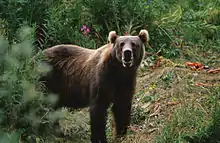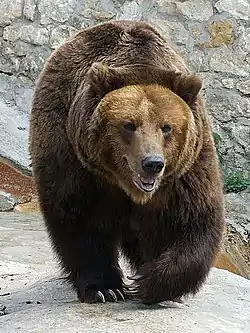熊
| ||||||||
Translingual
Han character
熊 (Kangxi radical 86, 火+10, 14 strokes, cangjie input 戈心火 (IPF), four-corner 21331, composition ⿱能灬)
References
- KangXi: page 679, character 10
- Dai Kanwa Jiten: character 19294
- Dae Jaweon: page 1090, character 32
- Hanyu Da Zidian (first edition): volume 3, page 2227, character 5
- Unihan data for U+718A
Chinese
| trad. | 熊 | |
|---|---|---|
| simp. # | 熊 | |
| alternative forms | 能 𤠗 𪏛 𧰯 | |

Glyph origin
| Historical forms of the character 熊 | ||||||||||||||||||
|---|---|---|---|---|---|---|---|---|---|---|---|---|---|---|---|---|---|---|
| Warring States | Shuowen Jiezi (compiled in Han) | Liushutong (compiled in Ming) | ||||||||||||||||
| Chu slip and silk script | Small seal script | Transcribed ancient scripts | ||||||||||||||||
 |
 |
 | ||||||||||||||||
| ||||||||||||||||||
|
References: Mostly from Richard Sears' Chinese Etymology site (authorisation),
| ||||||||||||||||||
According to Shuowen, phono-semantic compound (形聲, OC *ɢʷlɯm) : semantic 能 (“bear”) + abbreviated phonetic 炎 (OC *ɦlam).
This character originally represented an onomatopoetic word (熊熊 (xióngxióng, “(of flame) raging”)). Later its semantic component 能 (OC *nɯː, *nɯːs, *nɯːŋ, *nɯːŋʔ), the character for the Old Chinese word "bear", was borrowed for another word. This character thus began to represent the word "bear" instead.
Etymology
From Proto-Sino-Tibetan *d-wam. Cognate with Tibetan དོམ (dom, “bear”), Burmese ဝံ (wam) (in ဝက်ဝံ (wak-wam, “bear”)).
Pronunciation
Definitions
熊
Synonyms
- (bear):
- (to scold):
|
- (timid):
Compounds
|
|
|
Japanese
Compounds
- 牡熊 (osukuma): a male bear
- 子熊 (kokuma): a bear cub
- 小熊 (kokuma): a species of small bear
- 白熊 (shirokuma): a white bear (polar bear)
- 灰色熊 (haīrokuma): a grizzly bear
- 北極熊 (hokkyokuguma): a polar bear
- 黒熊 (kurokuma): the Asian black bear
- 熊笹 (kumazasa): bamboo grass (Sasa veitchii)
- 熊葛 (kumatsuzura): common vervain (Verbena officinalis)
- 熊手 (kumade): bamboo rake
- 熊襲 (Kumaso): the Kumaso people
- 雌熊 (mesukuma): a female bear; a she-bear
Etymology

| Kanji in this term |
|---|
| 熊 |
| くま Grade: 4 |
| kun’yomi |
From Old Japanese. First cited in the Kojiki of 712.[1]
Further derivation is uncertain. Possibilities include:
- Might be cognate with Japanese 隈 (kuma, “inside corner; inner bend; hollow or hole in something”), perhaps from the way that bears often live in dens.[2]
- Might also or separately be cognate with Middle Korean 곰〯 (kwǒm, “bear”), whose archaic form */koma/ is preserved as the first element of the toponym 고마〮ᄂᆞᄅᆞ (Kwòmánòlò, literally “Bear-ford”). Thus, a cognate of Korean 곰 (gom, “bear”) and Baekje 金馬 (*kəma/*kuma, “bear”).
- Might be an areal Wanderwort, borrowed from Old Chinese 熊 (OC *ɢʷlɯm) and ultimately deriving from Proto-Sino-Tibetan *d-wam. See also the etymology notes in the *d-wam entry.
Pronunciation
Noun
熊 • (kuma)
- [from 712] a bear (large mammal of family Ursidae)
- [from 1701] (slang) hairiness in general; (more specifically) a bear, an otter (a hairy man, especially one who is gay)
- [???] (theater) standing room only audience members in the pit (from the way the standing section would often have a metal railing or fence separating it, resembling a bear cage)
Usage notes
As with many terms that name organisms, this term is often spelled in katakana, especially in biological contexts (where katakana is customary), as クマ.
Derived terms
- 穴熊 (anaguma): Meles meles, the Eurasian badger
- 洗熊 (araiguma): a raccoon
Prefix
熊 • (kuma)
- [from 712] prefixed to other nouns for animals or plants to indicate large size or great strength, relative to other varieties
Derived terms
- 熊鼠 (kumanezumi): Rattus rattus, the black rat
References
- 1988, 国語大辞典(新装版) (Kokugo Dai Jiten, Revised Edition) (in Japanese), Tōkyō: Shogakukan
- Entry at Nihon Jiten (in Japanese)
- 2006, 大辞林 (Daijirin), Third Edition (in Japanese), Tōkyō: Sanseidō, →ISBN
- 1997, 新明解国語辞典 (Shin Meikai Kokugo Jiten), Fifth Edition (in Japanese), Tōkyō: Sanseidō, →ISBN
- 1998, NHK日本語発音アクセント辞典 (NHK Japanese Pronunciation Accent Dictionary) (in Japanese), Tōkyō: NHK, →ISBN
Korean
Etymology
From Middle Chinese 熊 (MC ɦɨuŋ).
| Historical Readings | ||
|---|---|---|
| Dongguk Jeongun Reading | ||
| Dongguk Jeongun, 1448 | ᅘᅮᇰ (Yale: hhwùng) | |
| Middle Korean | ||
| Text | Eumhun | |
| Gloss (hun) | Reading | |
| Hunmong Jahoe, 1527 | 곰〯 (Yale: kwǒm) | 우ᇰ (Yale: wùng) |
Pronunciation
- (SK Standard/Seoul) IPA(key): [uŋ]
- Phonetic hangul: [웅]
Okinawan
Etymology
| Kanji in this term |
|---|
| 熊 |
| くま Grade: 4 |
| kun’yomi |
Pronunciation
- IPA(key): [kuma]
References
- “くま【熊】” in JLect - Japonic Languages and Dialects Database Dictionary, 2019.

